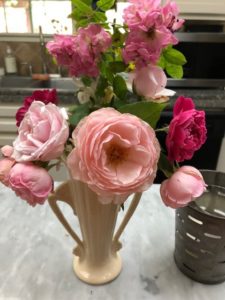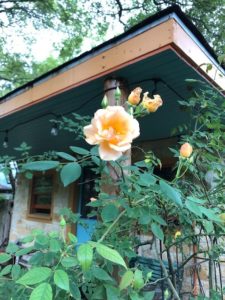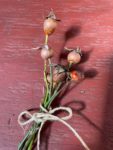
Bottom: ‘Duchesse de Brabant’; Middle: ‘Souvenir de la Malmaison’; Darker pink: ‘Maggie’; Top: ‘The Fairy’
Here in Central Texas, February is the month of on-and-off nasty weather, Valentine’s Day, and Presidents’ Day. All of these remind me it’s time to check on my roses. Choosing a mild day in Mid-February and arming myself with the necessary clothing (long sleeve shirt, hat, glasses, heavy gloves and no open toed shoes) I’m off to start the rose pruning process.
Check your Tools First
Before I start my rose pruning, I like to sharpen and then sterilize my clippers and pruners. Because you use your clippers/pruners so often, the blades can become dirty, rusty and carry bacteria that can then infect healthy plants. If you need help with this, search for the phrase “tool time care for pruning shears” on YouTube.
Know Your Rose
Know what kind of rose you are growing as each can have a little different need. In the Austin area, the best roses to grow are Earth-Kind® and/or Antique roses simply because they have been tried and tested for our area soil and climate.
Rose blooms fall into two types of cycles: single bloom and repeat bloom. Single blooming roses usually bloom once in spring. Repeat bloomers also bloom primarily in spring, but then keep blooming all the way through to frost. If you don’t don’t know which you have, skip pruning until you can determine the bloom cycle.
Rose Pruning Steps
If your rose blooms only once in the spring, wait until it has finished blooming before pruning.

Crepuscule, a noisette type climbing rose, should be pruned after it blooms.
The first step to pruning is to remove all dead or damaged canes and any that are crossing over another cane on the inside of the bush.
Second, lightly trim remainder of bush by removing about 1/3 of it’s outer growth.
Third, prune to shape or correct the growing pattern, especially if it’s interfering with walkways.
Fourth, prune out overcrowded inside canes to promote good air circulation. This helps to prevent black spot and other fungal and bacterial problems and reducing the need to spray.
When pruning, look for a bud that faces to the outside on the cane. This will focus new growth to the outside of the bush instead of to the inside. Remember to always pick up and discard any clippings, unless you wish to propagate them.
Deadheading and Summer Pruning
Don’t worry about precision pruning. In fact, sometimes roses seem to thrive with almost no cutting back at all. Most roses reach a peak of bloom about six weeks after pruning, because they bloom on the resulting flush of new growth. Here in Austin, repeat bloomers can be pruned lightly in August for fall blooms.
Should you “dead-head”? After a large flush of blooming, dead-heading (cutting off the spent or dead rose) can both look tidy and increase the next blooms to appear. Many gardeners find this type of activity therapeutic and calming (much like weeding.) It’s not necessary, especially if having the time to constantly dead-head is not available.

Rose hips are packed with vitamin C
One disadvantage to constantly deadheading is that you might not know which varieties form “hips.” Hips are the fruits of the rose and provide visual interest in your garden. Additionally, hips make tasty jams and tarts that are filled with lots of Vitamin C.
Compost After Pruning
After pruning, whether spring and late summer, compost is very welcome by your rose. Add a few shovels of wonderful compost around the base of the rose at the dripline and work it lightly into the soil above the roots.
Fertilize With Caution
If your soil test indicates it, add fertilizer after rose pruning. Obtaining a soil test is very important to ascertain the available phosphorus. Austin area soils are normally high in this nutrient, so the standard advice to add phosphorus to promote blooms may not apply to your garden. Excess phosphorus will limit the availability of other important soil nutrients, even if it’s an organic fertilizer.
Additional Resources
Best Roses for Austin and Travis County
Solving the Mystery of Pruning Roses by Dr. Douglas Welsh
Old Roses by Dr. William Welch
The Organic Rose Garden by Liz Druitt, Taylor Trade Publishing (April 1, 1996)
Heirloom Gardening in the South by William C. Welch and Greg Grant
February Gardening Checklist for Austin and Central Texas

Carolyn Williams and her husband live and garden west of Austin in the land of limestone and caliche. This will be her 21st year as a member of Travis County Master Gardeners Association, where she has held several offices including two years as President. Carolyn has chaired numerous committees , writes articles for the TCMGA Compost Bin, gives talks to local clubs and organizations, and is a certified Landscape Designer who always enjoys discovering the beauty and rhythms of her own garden.

